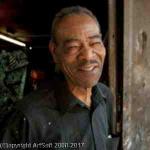Thornton Dial
Thornton Dial
Place: Emelle
Born: 1928
Death: 2016
Biography:
Thornton Dial was a pioneering African-American artist who came to prominence in the late 1980s. Dial's body of work exhibits formal variety through expressive, densely composed assemblages of found materials, often executed on a monumental scale. His range of subjects embraces a broad sweep of history, from human rights to natural disasters and current events. His works have been acquired by the Museum of Modern Art, the Whitney Museum of American Art, the Smithsonian American Art Museum, the American Folk Art Museum, the High Museum of Art in Atlanta, Georgia and most recently the de Young Museum of Art and the Philadelphia Museum of Art. Ten of Mr. Dial's works were acquired by the Metropolitan Museum of Art in 2014.
Thornton Dial was born in 1928 to a teenage mother, Mattie Bell, on a former cotton plantation in Emelle, Alabama, where relatives in his extended family worked as sharecroppers. He lived with his mother until he was around three when Dial and his half-brother Arthur moved in with their second cousin, Buddy Jake Dial, who was a farmer. When Thornton moved in with Buddy Jake, he farmed and learned about the sculptures that Buddy Jake made from items lying around the yard, an experience that influenced him. Dial grew up in poverty and without the presence of his father.
In 1940, when he was twelve, Dial moved to Bessemer, Alabama. When he arrived in Bessemer, he noticed the art along the way in people's yard and was amazed at the level of craft exhibited. He married Clara Mae Murrow in 1951. They have five children, one of whom died of cerebral palsy. The late artist Ronald Lockett was his cousin.
His principal place of employment was as a metalworker at the Pullman Standard Plant in Bessemer, Alabama, which made railroad cars. The plant closed its doors in 1981. After the Pullman factory shut down, Dial began to dedicate himself to his art for his own pleasure.
In 1987 Thornton Dial met Lonnie Holley, an artist who introduced Dial to Atlanta collector and art historian William Arnett. Arnett, whose art historical interests had now focused on African-American vernacular art and artists, brought Dial's work to national prominence. The art historian has also brought Lonnie Holley, the Gee's Bend Quilters and many others to the attention of the United States. Arnett, with Jane Fonda also helped to create a publishing company, in 1996, along with his sons Paul and Matt. He is also the founder and Chairman Emeritus of the Souls Grown Deep Foundation, an organization dedicated to the preservation and documentation of African American art.
Dial's work has been continually heralded in international cultural institutions and large survey exhibitions, such as the 2000 Whitney Biennial. Over time, the context for Dial's work has expanded to showcase the political and social responsiveness of his artwork, expressing "ideas about black history, slavery, racial discrimination, urban and rural poverty, industrial or environmental collapse, and spiritual salvation". Since 2011 the language surrounding Dial's artwork and practice has shifted. Most recently Alex Greenberger of ARTnews said: "Thornton Dial has been termed an outsider artist, a vernacular artist, and a folk artist—but any of those labels might be a misnomer, since the late painter's work has been gradually moving into the mainstream art world's view in the past few years."
Thornton Dial's work addresses American sociopolitical exigencies such as war, racism, bigotry and homelessness. He draws attention to these themes using the overlooked and under-considered material artifacts of everyday American life. Combining paint and found materials, Dial constructs large-scale assemblages with cast-away objects ranging from rope to bones to buckets. Works such as Black Walk and The Blood of Hard Times, for example, use corrugated tin and other dilapidated pieces of metal to refer to the destitute bodies and vernacular architecture of the rural South. Dial invokes the history of the American rural South throughout much of his work.
The symbol of the tiger is also a primary visual trope in Thornton Dial's oeuvre. Artist and African-American art historian David C. Driskell explains Dial's use of the tiger as an allegory for survival and an implicit reference to the struggle for civil rights in the United States.
In 2011, Dial's work was profiled in a four-page story in Time Magazine, where art and architecture critic Richard Lacayo argued that Dial's work should not be pigeon-holed into the narrowly-defined category of "outsider art":
Dial's work has sometimes been described as "outsider art", a term that attempts to cover the product of everyone from naive painters like Grandma Moses to institutionalized lost souls like Martín Ramírez and full-bore obsessives like Henry Darger, the Chicago janitor... But if there's one lesson to take away from "Hard Truths: The Art of Thornton Dial," a triumphant new retrospective at the Indianapolis Museum of Art, it's that Dial, 82, doesn't belong within even the broad confines of that category....What he does can be discussed as art, just art, no surplus notions of outsiderness required....And not just that, but some of the most assured, delightful and powerful art around.
More...
Wikipedia link: Click Here




